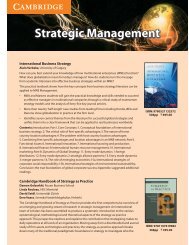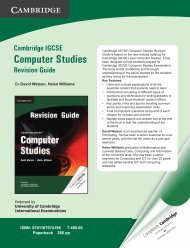ENGINEERING - Cambridge University Press India
ENGINEERING - Cambridge University Press India
ENGINEERING - Cambridge University Press India
Create successful ePaper yourself
Turn your PDF publications into a flip-book with our unique Google optimized e-Paper software.
Essential<br />
Bioinformatics<br />
Jin Xiong<br />
Texas A & M <strong>University</strong><br />
Contents: Preface; 1. Introduction; 2. Cellular<br />
biomechanics; 3. Hemodynamics; 4. The<br />
circulatory system; 5. The interstitium; 6. Ocular<br />
biomechanics; 7. The respiratory system;<br />
8. Muscles and movement; 9. Skeletal<br />
biomechanics; 10. Terrestrial locomotion;<br />
Appendix A. The electrocardiogram; Index.<br />
ISBN: 9780521165181 528pp ` 1050.00<br />
Essential Bioinformatics is a concise yet<br />
comprehensive textbook of bioinformatics that<br />
provides a broad introduction to the entire field.<br />
Written specifically for a life science audience, the<br />
basics of bioinformatics are explained; followed by<br />
discussions of the state-of-the-art computational<br />
tools available to solve biological research<br />
problems. All key areas of bioinformatics are<br />
covered including biological databases, sequence<br />
alignment, genes and promoter prediction,<br />
molecular phylogenetics, structural bioinformatics,<br />
genomics, and proteomics. The book emphasizes<br />
how computational methods work and compares<br />
the strengths and weaknesses of different<br />
methods. This balanced yet easily accessible text<br />
will be invaluable to students who do not have<br />
sophisticated computational backgrounds.<br />
Technical details of computational algorithms are<br />
explained with a minimum use of mathematical<br />
formulas; graphical illustrations are used in their<br />
place to aid understanding. The effective synthesis<br />
of existing literature as well as in-depth and up-todate<br />
coverage of all key topics in bioinformatics<br />
make this an ideal textbook for all bioinformatics<br />
courses taken by life science students and for<br />
researchers wishing to develop their knowledge of<br />
bioinformatics to facilitate their own research.<br />
Contents: Preface; Part I. Introduction and<br />
Biological Databases: 1. Introduction;<br />
2. Introduction to biological databases; Part II.<br />
Sequence Alignment: 3. Pairwise sequence<br />
alignment; 4. Database similarity search;<br />
5. Multiple sequence alignment; 6. Profiles and<br />
hidden Markov models; 7. Protein motifs and<br />
patterns; Part III. Gene and Promoter Prediction:<br />
8. Gene prediction; 9. Promoter and regulatory<br />
element prediction; Part IV. Molecular<br />
Phylogenetics: 10. Phylogenetics basics;<br />
11. Phylogenetic tree construction methods and<br />
programs; Part V. Protein Structure Basics:<br />
12. Protein structure basics; 13. Protein structure<br />
visualization, comparison and classification;<br />
14. Protein secondary structure prediction;<br />
15. Protein tertiary structure prediction; 16. RNA<br />
structure prediction; Part VI. Genomics and<br />
Proteomics: 17. Genome mapping, assembly and<br />
comparison; 18. Functional genomics;<br />
19. Proteomics; Practical exercises; Glossary.<br />
ISBN: 9780521706100 339pp ` 445.00<br />
Biomedical<br />
Engineering<br />
Bridging Medicine and<br />
Technology<br />
W. Mark Saltzman<br />
Yale <strong>University</strong>,<br />
Connecticut<br />
Commercialising<br />
Successful<br />
Biomedical<br />
Technologies<br />
Basic Principles for the<br />
Development of Drugs,<br />
Diagnostics and Devices<br />
Shreefal S. Mehta,<br />
Cytopia<br />
This is an ideal text for an introduction to<br />
biomedical engineering. The book presents the<br />
basic science knowledge used by biomedical<br />
engineers at a level accessible to all students and<br />
illustrates the first steps in applying this knowledge<br />
to solve problems in human medicine. Biomedical<br />
engineering encompasses a range of fields of<br />
specialization including bioinstrumentation,<br />
bioimaging, biomechanics, biomaterials, and<br />
biomolecular engineering. This introduction to<br />
bioengineering assembles foundational resources<br />
from molecular and cellular biology and physiology<br />
and relates them to various sub-specialties of<br />
biomedical engineering. The first two parts of the<br />
book present basic information in molecular/<br />
cellular biology and human physiology;<br />
quantitative concepts are stressed in these<br />
sections. Comprehension of these basic life<br />
science principles provides the context in which<br />
biomedical engineers interact. The third part of the<br />
book introduces sub-specialties in biomedical<br />
engineering, and emphasizes - through examples<br />
and profiles of people in the field - the types of<br />
problems biomedical engineers solve.<br />
Contents: 1. Introduction; Part I. Molecular and<br />
Cellular Principles: 2. Biomolecular principles;<br />
3. Biomolecular principles: nucleic acids;<br />
4. Biomolecular principles: proteins; 5. Cellular<br />
principles; Part II. Physiological Principles:<br />
6. Communication systems in the body;<br />
7. Engineering balances: respiration and<br />
digestion; 8. Circulation; 9. Removal of molecules<br />
from the body; 10. Biomechanics;<br />
11. Bioinstrumentation; 12. Bioimaging;<br />
13. Biomolecular engineering and biotechnology;<br />
14. Biomolecular engineering II: engineering of<br />
immunity; 15. Biomaterials and artificial organs;<br />
16. Biomedical engineering and cancer.<br />
ISBN: 9780521840996 656pp $ 105.00<br />
Successful product design and development<br />
requires the ability to take a concept and translate<br />
the technology into useful, patentable, commercial<br />
products. This book guides the reader through the<br />
practical aspects of the commercialization process<br />
of drug, diagnostic and device biomedical<br />
technology including market analysis, product<br />
development, intellectual property and regulatory<br />
constraints. Key issues are highlighted at each<br />
stage in the process, and case studies are used to<br />
provide practical examples. The book will provide<br />
a sound road map for those involved in the<br />
biotechnology industry to effectively plan the<br />
commercialization of profitable regulated medical<br />
products. It will also be suitable for a capstone<br />
design course in engineering and biotechnology,<br />
providing the student with the business acumen<br />
skills involved in product development.<br />
Contents: Foreword; Glossary; 1. Biomedical<br />
device and drug design industry and markets;<br />
2. Markets of interest and market research steps;<br />
3. Intellectual property and licensing; 4. Product<br />
60

















